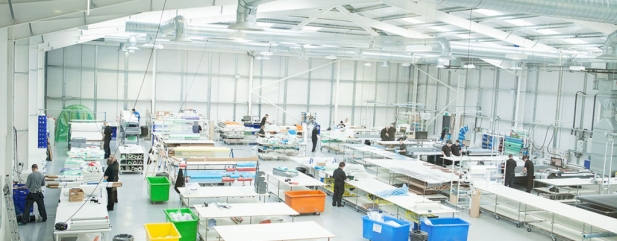Archived article
Please note that tax, investment, pension and ISA rules can change and the information and any views contained in this article may now be inaccurate.
The rapid growth story flying under the radar

Burnley-based Velocity Composites (VEL:AIM) makes aerospace composite material kits. It joined the stock market in May but remains under the radar of most investors. We think it is worth a closer look.
A composite is an umbrella term to describe a number of materials, usually made up of two different components that together have very different properties than the individual elements.
Bridges gives the example of ‘pre-impregnated materials, such as woven fabrics pre-impregnated with resin’.
‘We don’t manufacture any materials; there are already large multinational material suppliers who are on pricing agreements with the likes of Airbus and Boeing,’ explains chief executive Jon Bridges.
‘Neither do we manufacture any parts as there’s already a large parts manufacturing supply chain feeding into the aircraft assembly line.’
So what does the company do?
Velocity sits between the material and manufacturing companies and consolidates the diverse supply chain. Its kits remove waste and shorten the length of production process.
If an airline materials manufacturer tried to do this in-house, they would have to buy all the composite rolls in advance and store them in freezers as the materials are fragile.
Then they’d have to cut the material into two dimensional shapes after defrosting them. This would lead to wastage of materials; essentially in-house production is inefficient.
Bridges says: ‘By us doing all that work upfront for them, it makes it more efficient, less wasteful and more repeatable so they focus on their core business.’
Production challenges
The entire composites industry is facing a challenge to scale up its production as components transition from being niche towards volume manufactured goods.
The composites supply chain and logistics will need investment and change in order to facilitate this growth. This is where Velocity Composites’ efficiencies make it a unique offering.
David Buxton, an analyst at the company’s broker FinnCap, says Velocity’s growth ‘is driven by a number of factors including volume growth on existing aircraft programmes, recently won customer contracts ramping up over the next two years and the start of production on new aircraft platforms’.
Why not cut out the middle man?
While it would be inefficient for an aerospace parts company to make what it needs in-house, surely that business could just take Velocity’s entire process and make it a division of their company?
Bridges dismisses this notion as his firm has spent 10 years developing bespoke software to make its business as efficient as possible, thus hard to replicate.
By cutting raw materials to size before the manufacture of the structural composite components, it can provide these kits in a timely and competitively priced way.
And by focusing on such a niche part of the market, it has refined its processes to such an extent that companies are happy to outsource what can be an expensive albeit essential part of aeroplane manufacturing.
Evolution and key clientele
The use of composites in aircrafts has been growing steadily. Over the last 15 years their use has grown from marginal to over 50% of the structural body of modern wide body jets.
This trend is forecast to continue as there are commercial pressures to reduce the weight of planes to save on fuel costs.
These commercial considerations are coupled with regulatory pressures for aircrafts to improve their fuel efficiency and emissions. Composites are also stronger and more durable than aluminium.
This growth in use of composites is an obvious boon for Velocity as the likes of aerospace giants like Boeing and Airbus have huge order backlogs to fulfil.
According to FinnCap’s Buxton, the company is forecasting sales growth from existing customer programmes who have ramped up their production of planes such as the B787 Dreamliner, A350 and A330neo.
Shares have yet to take off
At 86.5p, Velocity Composites is trading only marginally above its 85p IPO (initial public offering) price.
Buxton says this represents an opportunity not a disappointment. He claims that nothing has changed in the group’s strategy, market conditions or production visibility. ‘We believe the current valuation is compelling, standing at a significant discount to aerospace sector, while the growth story provides significant attractions.’
The analyst believes the share price could hit 144p in the next year, representing 66% potential upside.
Financial results for the six months to 30 April 2017 indicate a growing company. Revenue was up 31% to £9.3m and gross profit increased by 19% to £1.9m.
Don’t be fooled by a pre-tax loss of £35,000 as it doesn’t accurately represent the underlying health of the business.
That negative figure was a result of costs associated with its stock market flotation and investing in a new facility in Fareham.
The company is forecast to report a full year pre-tax profit of £0.5m in the year to October 2017, rising to £3.8m in 2018 and £6m in 2019. Those are very attractive levels of growth.
Risks to consider
The civil aerospace industry is subject to cyclical up and down swings. As for Brexit-related risks, we note aircrafts and their parts are tariff-exempt under WTO (World Trade Organization) rules.
‘Many of the company’s current and potential customers are involved in the Airbus supply chain. These customers have a complex, integrated, multinational supply chain. The location of Airbus’s suppliers, and the jobs attached remain a politically sensitive issue,’ says Buxton, discussing the Brexit issue.
‘Brexit may in future result in some shift in purchasing patterns, although at this stage, this is a matter of longer-term conjecture. Velocity’s strategy to expand geographically would provide a defence to this issue.’

Velocity Composites is a vital component of multi-billion
pound industry. A speculative buy at 86.5p.
Important information:
These articles are provided by Shares magazine which is published by AJ Bell Media, a part of AJ Bell. Shares is not written by AJ Bell.
Shares is provided for your general information and use and is not a personal recommendation to invest. It is not intended to be relied upon by you in making or not making any investment decisions. The investments referred to in these articles will not be suitable for all investors. If in doubt please seek appropriate independent financial advice.
Investors acting on the information in these articles do so at their own risk and AJ Bell Media and its staff do not accept liability for losses suffered by investors as a result of their investment decisions.
Issue contents
Big News
- Brexit puts squeeze on consumers and businesses
- Pressure on Blancco Technology
- Keep toasting cash-generative Conviviality
- Yu Group to beat forecasts
- Weir seeing North American shale recovery
- Carillion bailed out by HS2
- What will McCall do at ITV?
- Sage to sidestep HMRC’s digital delay
- EasyJet reveals post-Brexit plans as CEO departs

 magazine
magazine










